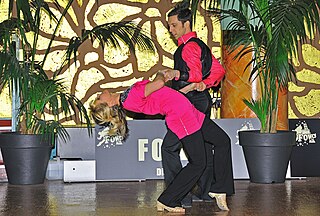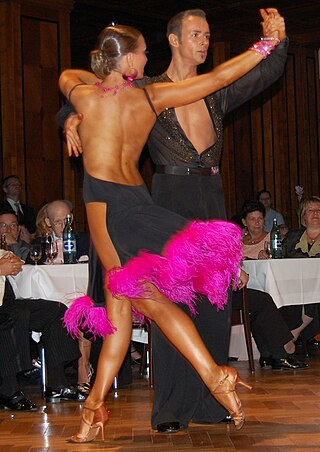Related Research Articles

Ballroom dance is a set of partner dances, which are enjoyed both socially and competitively around the world, mostly because of its performance and entertainment aspects. Ballroom dancing is also widely enjoyed on stage, film, and television.

East Coast Swing (ECS) is a form of social partner dance. It belongs to the group of swing dances. It is danced under fast swing music, including lindy hop, rock and roll and boogie-woogie.

The waltz, meaning "to roll or revolve") is a ballroom and folk dance, normally in triple, performed primarily in closed position.

West Coast Swing is a partner dance with roots in Lindy Hop. It is characterized by an elastic look that results from its extension-compression technique of partner connection and is danced primarily in a slotted area on the dance floor. The dance allows for both partners to improvise steps while dancing together, putting West Coast Swing in a short list of dances that emphasize improvisation.

Swing dance is a group of social dances that developed with the swing style of jazz music in the 1920s–1940s, with the origins of each dance predating the popular "swing era". Hundreds of styles of swing dancing were developed; those that have survived beyond that era include Lindy Hop, Balboa, Collegiate Shag, and Charleston. Today, the best-known of these dances is the Lindy Hop, which originated in Harlem in the early 1930s. While the majority of swing dances began in African-American communities as vernacular African-American dances, some influenced swing-era dances, like Balboa, developed outside of these communities.

Partner dances are dances whose basic choreography involves coordinated dancing of two partners, as opposed to individuals dancing alone or individually in a non-coordinated manner, and as opposed to groups of people dancing simultaneously in a coordinated manner.

Jitterbug is a generalized term used to describe swing dancing. It is often synonymous with the lindy hop dance but might include elements of the jive, east coast swing, collegiate shag, charleston, balboa and other swing dances.

Frank Manning was an American dancer, instructor, and choreographer. Manning is considered one of the founders of Lindy Hop, an energetic form of the jazz dance style known as swing.
Dean Collins was an American dancer, instructor, choreographer, and innovator of swing dance. He is often credited with bringing the Lindy Hop from New York to southern California. Collins worked in over thirty films and performed live and on television.
Whitey's Lindy Hoppers was a professional performing group of exceptional swing dancers that was first organized in the late 1920s by Herbert "Whitey" White in the Savoy Ballroom and disbanded in 1942 after its male members were drafted into World War II. The group took on many different forms and had several different names and sub-groups, including Whitey's Hopping Maniacs, Harlem Congeroo Dancers, and The Hot Chocolates. In addition to touring nationally and internationally, the group appeared in several films and Broadway theatre productions. Dorothy Dandridge and Sammy Davis Jr. were among the group's celebrity regulars.
Al Minns, was a prominent American Lindy Hop and jazz dancer. Most famous for his film and stage performances in the 1930s and 1940s with the Harlem-based Whitey's Lindy Hoppers, Minns worked throughout his life to promote the dances that he and his cohorts helped to pioneer at New York's Savoy Ballroom. In 1938, Al Minns and Sandra Gibson won the Harvest Moon Ball.
Sylvia Sykes is an American swing dancer, instructor, judge, and choreographer. She is known for reviving the swing dance style balboa.

The history of Lindy Hop begins in the African American communities of Harlem, New York during the late 1920s in conjunction with swing jazz. Lindy Hop is closely related to earlier African American vernacular dances but quickly gained its own fame through dancers in films, performances, competitions, and professional dance troupes. It became especially popular in the 1930s with the upsurge of aerials. The popularity of Lindy Hop declined after World War II, and it converted to other forms of dancing, but it never disappeared during the decades between the 1940s and the 1980s until European and American dancers revived it starting from the beginning of the 1980s.

Queen of the Stardust Ballroom is an American musical television movie directed by Sam O'Steen and produced by Roger Gimbel, from the teleplay by Jerome Kass. It was broadcast by CBS on February 13, 1975. Maureen Stapleton, Charles Durning, and Charlotte Rae were nominated for Emmy Awards for their performances.
The Aragon Ballroom on Lick Pier in the Ocean Park district of Santa Monica, California was a social-dance venue opened under the Aragon name in March 1942 by dance promoter Harry Schooler (1918–2008).

The BYU Ballroom Dance Company originates in the Department of Dance of the College of Fine Arts and Communications at Brigham Young University (BYU) in Provo, Utah. It has been a part of BYU for nearly 50 years and competes and performs throughout the world.
Skippy Blair was an American ballroom dancer credited with popularizing "West Coast Swing." Blair was a member of a group that successfully lobbied the State Legislature in 1988 to have West Coast Swing designated as the official State Dance of California. She was also the founder of the Golden State Dance Teachers Association and a co-founder of the World Swing Dance Council.

Frank Veloz (1906–1981) and Yolanda Casazza (1908–1995) were a self-taught American ballroom dance team, husband and wife, who became stars in the 1930s and 1940s, and were among the highest paid dance acts during that era. They performed on stage in productions such as Hot-Cha!, which ran for 119 shows on Broadway in 1932. They also appeared in popular films such as Under the Pampas Moon (1935), The Pride of the Yankees (1942), Honeymoon Lodge (1943), Brazil (1944) and The Thrill of Brazil (1946), the latter of which is credited as being of major importance to the growth in popularity of Samba in America.

The Lindy Hop is an American dance which was born in the African-American communities of Harlem, New York City, in 1928 and has evolved since then. It was very popular during the swing era of the late 1930s and early 1940s. Lindy is a fusion of many dances that preceded it or were popular during its development but is mainly based on jazz, tap, breakaway, and Charleston. It is frequently described as a jazz dance and is a member of the swing dance family.
References
- ↑ "History". Balboapavilion.com. Archived from the original on 2011-02-02. Retrieved 2017-02-24.
- ↑ Stevens, Tamara; Stevens, Erin (2011-04-07). Swing Dancing. ABC-CLIO. p. 105. ISBN 9780313375187 . Retrieved 2020-05-18.
- ↑ History: Over 100 years of history surrounds the pavilion., Balboa Manor, archived from the original on 2011-02-02, retrieved 2020-05-18
- ↑ Shine, Nicole (2014-01-22), Balboa: Depression-era dance halls left a footloose legacy, The Orange County Register, retrieved 2020-05-19
- ↑ Stevens, Tamara (2011). Swing dancing. The American dance floor. Santa Barbara, Ca.: Greenwood. p. 118. ISBN 978-0-313-37517-0.
- ↑ Stevens, Tamara (2011). Swing dancing. The American dance floor. Santa Barbara, Ca.: Greenwood. p. 117. ISBN 978-0-313-37517-0.
- ↑ Dubin, Zan (1995-09-07), "Doing the Balboa Puts a Little Swing in Brea", The Los Angeles Times, retrieved 2020-05-19
- ↑ Stevens, Tamara; Stevens, Erin (2011-04-07). Swing Dancing. ABC-CLIO. p. 119,151–153. ISBN 9780313375187 . Retrieved 2020-05-18.
- ↑ Ballroom Dance Rhythms. Alma Heaton. 1954. Brigham Young University Press. pages 35, 36
- ↑ Techniques of Teaching Ballroom Dance. Alma Heaton. 1965. Brigham Young University Press. Third Edition. pages 161,162
- ↑ Ballroom Dance Rhythms. Alma Heaton. 1967. Brigham Young University Press. pages 75, 76